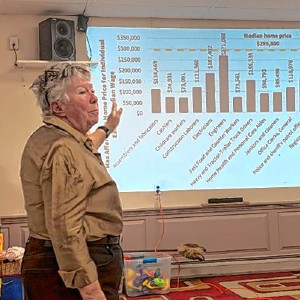Goodell Company Mill building added to National Register of Historic Places
| Published: 01-25-2023 11:33 AM |
The Goodell Company Mill building in downtown Antrim has been added to the National Register of Historic Places.
The old factory building, owned and operated by David Goodell in the 1800s, now houses the Moka Pot with its shop window facing Main Street and a sign out front that reads “Antrim Mill Offices, 42 Main Street.”
Goodell was born in Hillsborough and moved to Antrim with his family when he was 7. He attended Brown University, although he didn’t graduate. He was a teacher and planned to be a farmer when he moved back to Antrim in the 1850s, but in 1857, the Antrim Shovel Company was founded and Goodell was hired as its treasurer and bookkeeper. The next year, he became a general agent. He stayed on when the business was sold to Treadwell and Co., but when it was sold again to Oakes Ames, who moved the company to Massachusetts, Goodell stayed in Antrim.
Antrim Historical Society Board of Trustees member and archivist Neil Brown said the story is that Goodell “had an interest in developing something that would help his mother in the kitchen.”
In 1863 Goodell patented an apple-parer and then started manufacturing them. His most-popular model was the White Mountain lathe style. Brown said in 1866 he went on a two-week tour and sold 2,000 of his parers. By 1904, the company had manufactured 300,000.
“In the meantime he had a cutlery business,” Brown said. He bought a Bennington-based business, Wood’s Cutlery, and moved it to Antrim.
Goodell owned a number of buildings in town.
“Over the years he had a sawmill, he had a cucumber shop,” said Brown, explaining that the cucumber shop made utensils with wood from cocobolo trees that grow in South America. The workers thought the wood smelled like cucumbers, thus the name.
Article continues after...
Yesterday's Most Read Articles
 Crash on Route 202 in Jaffrey leads to trapped driver, fuel spill
Crash on Route 202 in Jaffrey leads to trapped driver, fuel spill
 Bernie Watson of Bernie & Louise dies at 80
Bernie Watson of Bernie & Louise dies at 80
 BUSINESS QUARTERLY – New housing projects could provide relief
BUSINESS QUARTERLY – New housing projects could provide relief
 Scott Bakula starring in Peterborough Players’ ‘Man of La Mancha’
Scott Bakula starring in Peterborough Players’ ‘Man of La Mancha’
 Children and the Arts Festival in Peterborough will have bird theme
Children and the Arts Festival in Peterborough will have bird theme
Goodell also owned other factory buildings, but the Goodell Company Mill was the main manufacturing hub.
“He brought electricity to Antrim in 1891,” said Brown. “He needed power for his factory and he built a power plant.”
Goodell built a water wheel on Great Brook, which flows behind the mill building, that provided electricity for lights in the mill building. Goodell then decided to build a water wheel on the Contoocook River, which would provide electricity to light all of his buildings. The new water wheel had enough power for 1,400 lights.
In addition to his manufacturing accomplishments, Goodell was governor of New Hampshire for one term.
Goodell died in 1915 and left the business to his sons. The business shrunk, although the cutlery side continued to run until it was bought by Chicago Cutlery in 1983.
In the top floor of the James A. Tuttle Library is the Historical Society Museum. Behind glass cases, Brown motioned to a number of artifacts that Goodell’s company had produced: apple-parers, antler-handled cutlery, a pencil sharpener, putty knives and ice spikes. On top of a shelf, the museum has a collection of seed dispensers used for farming. Brown said Goodell even made hammock swings and hunting knives.
The Goodell Company Mill building is now privately owned, and Brown said the owner plans to make it a combination of commercial and rental space.

 End Sexual Violence on Campus group holding April 27 event
End Sexual Violence on Campus group holding April 27 event BUSINESS QUARTERLY: Grants allow towns to study housing
BUSINESS QUARTERLY: Grants allow towns to study housing BUSINESS QUARTERLY: Dan Petrone – A guide to the commission settlement
BUSINESS QUARTERLY: Dan Petrone – A guide to the commission settlement
